| | Damage | Life cycle and identification | Monitoring | Pest management | Cultural control
Sitodiplosis mosellana
The wheat midge (Sitodiplosis mosellana) is found in most areas around the world wherever wheat is grown (Figure 1). In recent years, significant damage to wheat crops has been reported in Alberta, Saskatchewan, Manitoba, southern British Columbia, Minnesota, North Dakota and Idaho.
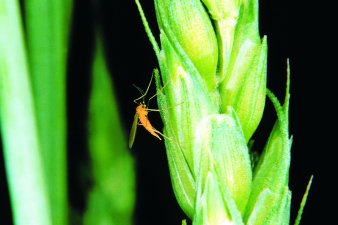
Figure 1. Side view of the wheat midge resting on wheat spikelets
All wheat varieties are currently susceptible to wheat midge, but some are more seriously affected than others. Although the midge also attacks other members of the grass family, including barley, couch grass, intermediate wheat grass and rye, infestations on these plants are usually not serious enough to warrant control.
Research and breeding for wheat midge resistant wheat varieties is underway at the Cereals Research Centre (Agriculture and Agri-Food Canada Winnipeg) and the Crop Development Centre (University of Saskatchewan).
Damage
Infestations of wheat midge can reduce crop yields and lower the grade of the harvested grain.
Midge may exist at low population levels for several years before they become a significant problem. But if conditions become favourable, populations can reach epidemic proportions quickly.
Producers inexperienced with wheat midge infestations often mistake the symptoms of damage and report that frost or drought was responsible for reduced wheat yields or grain quality.
Crop damage occurs during the larval stage. After hatching, the midge larvae feed on the developing wheat kernel, causing it to shrivel, crack and become deformed. As there are no visible, external changes in colour, size or shape of the affected wheat head, the damage to the crop is not readily apparent. Damage can only be detected by inspecting the developing seed within the glumes.
Damage to wheat kernels will vary within a single head. A few kernels may be aborted entirely. Others will not fully develop and will be so small and light, they will pass through the combine with the chaff during harvest. Still others may be only slightly damaged. Some kernels may not be affected at all.
The loss of kernels lowers the yield, whereas damaged kernels reduce the grade of the harvested wheat. Standards established by the Canadian Grain Commission limit midge damage in No. 1 CWRS and No. 2 CWRS to 2 per cent and 8 per cent respectively, before grade is affected. Damage tolerances for amber durum are 2 per cent for No. 1 CWAD and 8 per cent for No. 2 CWAD. However, if disease associated with midge damage, referred to as severe midge damage, grading tolerances are only 0.1 per cent and 0.25 per cent for CWAD No. 1 and No. 2 respectively. More detailed information regarding grading is available at the Canadian Grain Commission web site in Chapter 4 - Wheat, of the Official Grain Grading Guide
Life Cycle and Identification
The life cycle of the wheat midge has four stages.
Adult
The adult midge is a very small, fragile orange fly about half the size of a mosquito, approximately 2 to 3 mm long. Two black eyes cover much of its head. The midge has three pairs of legs that are long relative to its body size. Its wings are oval shaped, transparent and fringed with fine hairs. Adult midge emerge from the pupal stage in late June or early July. During the day, adults remain within the crop canopy where conditions are humid. In the evening, females become active at the top of the wheat canopy, laying eggs on the newly emerged wheat heads. Female midge, who live for less than seven days, lay an average of 80 eggs.
Eggs
Egg laying generally takes place after 8:30 p.m. when wind speeds are less than 10 km/h and the air temperature is greater than 15°C. Eggs are laid, either singly or in clusters of three or four eggs, on the florets, on the external surface of the glumes or in outer grooves on the florets. The egg stage lasts four to seven days, depending on environmental conditions, especially temperature.
Larvae
Upon hatching, the small orange larvae move from the outer surface into the head to feed on the surface of developing kernels (Figure 2.). Frequently, three to four larvae per floret have been observed, but in severe infestations, there may be as many as 26 larvae feeding on a single kernel.
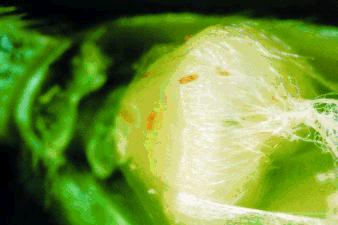 | 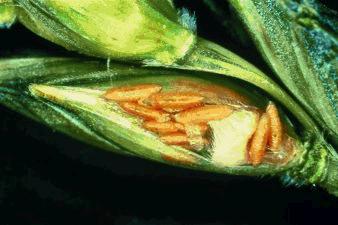 |
| Figure 2. Wheat midge larvae feeding on developing wheat kernel. Left: early stage of kernel development. Right: mature larvae - kernel severely damaged |
Larvae feed and develop for two to three weeks, growing to 2 to 3 mm in length, before crawling off the wheat head to find their way to the ground and bury themselves in the soil.
Under dry conditions, larvae will remain in the head and, rather than shedding their last larval skin, will shrink back inside the skin and stop developing. The larvae appear to be enclosed within a transparent envelope and can survive for some time in this protected state. The larvae will become active when moisture conditions improve and may move into the soil. However, the larvae may also remain in the wheat heads until threshed out during harvest.
Most larvae remain within the top 5 cm (2 inches) of soil, but some may burrow 10 cm (4 inches) below the soil surface. The larvae spin round cocoons that are about half the size of a Polish-type canola seed. (Figure 3). Over-wintering larvae may remain dormant until conditions are favourable for development, whether that is the following spring or several years later.
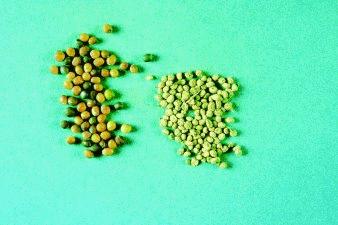
Figure 3. Canola seeds (left) and wheat midge cocoons (right)
Pupae
Once temperature and soil conditions end the over-wintering period, the larvae become active and move to the soil surface to pupate. Depending on the conditions, the larvae will pupate with or without a cocoon (Figure 4). Temperature, soil moisture and geographic location will affect the emergence of the adult flies, which begins in late June or early July. Emergence can continue for up to six weeks.
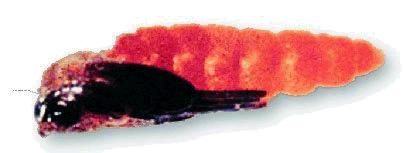
Figure 4. Wheat midge pupae
Monitoring
Careful, regular monitoring of wheat fields between heading and flowering is necessary both to identify a wheat midge infestation and to take the appropriate action.
Research indicates that wheat heads are most susceptible to damage when egg laying occurs during heading (Figure 5). Kernel damage due to wheat midge declines by 15 to 25 fold between later stages of heading and early flowering or anthesis (first yellow anthers appear on wheat head). Therefore, fields should be inspected daily from the time wheat heads emerge from the boot leaf until anthers are visible on the heads.
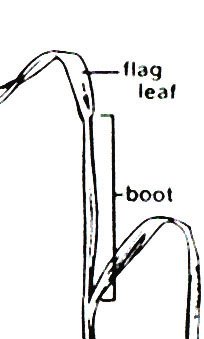
Boot swollen | 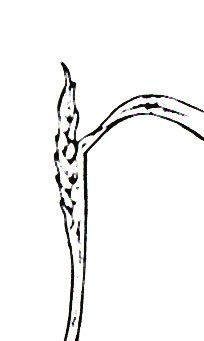
1/4 of ear emerged | 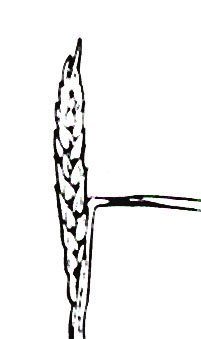
1/2 of ear emerged |
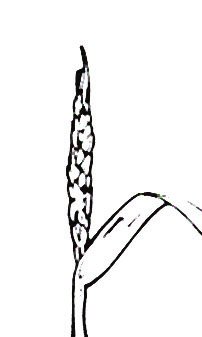 | 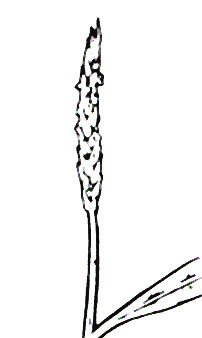 | 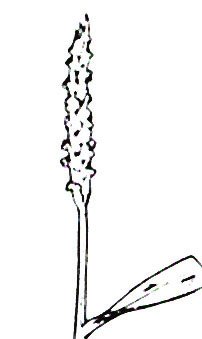 |
Ear emergence complete | Beginning of flowering -
flower parts at top of ear visible | Flowering complete too late for sprays |
Figure 5. Growth stages of wheat.
Exception
Glenlea wheat remains very susceptible to damage throughout anthesis. Monitor this variety carefully throughout the heading and flowering stages.
Field inspection should be carried out after 8:30 p.m. when the female midge are most active. Females are more active when the temperature is above 15°C (59°F) and wind speed is less than 10 km/h (6 mph). When wind speeds are greater than 10 km/h, egg-laying may still occur on shorter, tillering heads within the shelter of the crop canopy. Midge populations can be estimated by counting the number of adults present on four or five wheat heads.
Inspect the field in at least three or four locations. Midge densities and plant growth stages at the edge and centre of fields may be very different. The highest densities are often next to fields where wheat was grown in previous years or in low spots where soil moisture is favourable to midge development.
Midge infestations are often higher at field edges, with populations declining dramatically toward inner parts of the same field. In these situations, control around the field margins may provide adequate control and result in reduced cost. However if midge densities remain relatively constant at all sampling sites, control over the entire field is warranted.
Don't confuse wheat midge with lauxanids.
Not every small fly in the crop will be a wheat midge. The wheat midge may be mistaken for lauxanid, another small fly that is common in wheat (Figure 6).
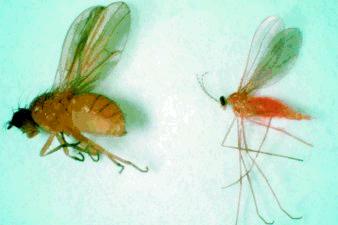
Figure 6. Lauxanid, Camptoprosopella borealis (left) and wheat midge (right)
At 2.5 to 4 mm in length (1/10-1/6 inches), the lauxanid is a little larger than the midge. It is yellowish-brown compared to the predominantly orange colour of the midge.
The lauxanid may be observed during the day and early evening resting on the wheat leaves or the awns. When disturbed during the day, it will fly above the crop canopy. At rest, its body will be oriented in a horizontal position or with its head pointed towards the ground. In contrast, the midge is usually not active during the day. Wheat midge tends to flutter from plant to plant and assumes a vertical position with its head pointed skyward when resting on the plants. See Table 1.
Table 1. Wheat midge/lauxanid differences
| Characteristics | Wheat midge | Lauxanid |
| Size | 2 - 3 mm
(1/12 - 1/8 in.) | 2.5 - 4 mm
(1/10-1/6 in.) |
| Colour | orange, brown head, black eyes | yellowish-brown) |
| Active period | primarily evening | day and evening |
| Movement habits | tends to flutter from plant to plant in the evening | will fly above the canopy when disturbed during day |
| Stationary habits | sits with head pointing up | sits on plant in horizontal position or pointing down |
Pest Management
Biological, cultural and chemical controls affect wheat midge populations.
Biological control
On the prairies, wheat midge populations are often held in check by a small, 1 to 2 mm (1/25-1/12 inches) long parasitic wasp called Macroglenes penetrans (Kirby) (Figure 7). In southern B.C., another small parasitic wasp, Euxestonotus error (Fitch) attacks the wheat midge similar to M. penetrans.
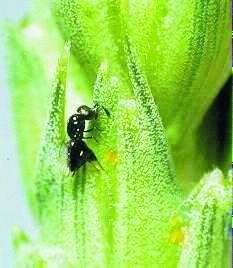
Figure 7. Female (with midge eggs)
The small wasp emerges from its pupa about the same time as its host and lays its eggs inside those of the wheat midge. The wasp egg and the midge egg hatch about the same time, and the tiny wasp grows slowly inside the midge larva.
Parasitized midge larvae are still capable of damage to the crop during the current season. The wasp remains dormant within the midge larva over winter. In the following spring, the parasite grows rapidly, destroying the midge larva.
Remember that benefits from parasitism will not be realized until the following year. While wheat is susceptible to
damage, control measures should be considered in the current year if midge populations exceed the economic threshold.
Estimates of parasite activity from samples collected for the annual wheat midge surveys conducted in Saskatchewan have indicated parasitism rates ranging from 0 to 100 per cent in the province. Generally, the highest percentages of parasitism occur in areas where midge populations have been established for a few years. By contrast, the lowest rates of parasitism are usually seen in areas new to the wheat midge and where the parasite has not yet become established.
Cultural Control
Avoid continuous wheat cropping because this practice favours the build-up of midge populations. When wheat midge populations are high in the soil of a particular field, it is best to switch from wheat to crops that are not susceptible to midge, such as oilseeds and pulse crops. Cereals crops such as barley, oats and annual canary grass can also be grown with little or no risk of damage.
Seeding dates
Research trials with early and later seeding dates have had variable results in reducing midge damage, depending on variety and wheat classes. Tests with traditional spring wheat varieties showed that early seeding of early maturing varieties resulted in greatly reduced midge damage. These early maturing varieties tended to grow through the susceptible stage before the wheat midge emerged from the soil.
However, recent tests with newer spring wheat, CPS and durum varieties showed late seeding resulted in the least amount of damage from the midge. This result appears to be related to the fact that the new, higher yielding spring wheat, CPS and durum varieties head out over a longer time and therefore remain susceptible longer. For these varieties, the susceptible stage and midge presence in the field coincided, so early seeding does not appear to be a viable, non-chemical control option.
Another complicating factor in the more recent trials is that the testing was done during "el Nino" years, with unique environmental conditions. Further testing will be required before any reliable recommendations can be made. Early seeding of early maturing spring wheat varieties may still be a useful method for non-chemical management of midge populations.
Soil type was another variable identified when considering seeding dates in cultural control. Days to heading was, on average, five to six days longer on heavy textured soil than on light-textured soil, therefore extending the time the wheat was susceptible to midge damage. More detailed information is available at the Agriculture and Agri-Food Canada website. (Research Letters at http://res2.agr.ca/saskatoon/)
Chemical control: action or economic threshold - always follow label directions
Yield considerations - An insecticide application is recommended when there is at least one adult midge for every four or five wheat heads. At this level of infestation, wheat yields will be reduced by approximately 15 per cent if the midge is not controlled. Higher midge densities will reduce yields even further.
Grade considerations - The Canadian Grain Commission's changes to grading tolerances have prompted the re-evaluation of the economic threshold for wheat midge to maintain optimum grades. In areas where growing conditions are favourable to the production of No. 1 grade wheat, chemical control may be required when midge populations reach one adult midge for every eight to ten wheat heads during the susceptible stage.
Cygon, Lagon, Lorsban 4E, Nufos and Pyrinex, are registered for the control of wheat midge in wheat in Canada. An insecticide application is recommended if the action threshold has been reached before the crop has flowered. The timing of the application will vary with the insecticide being used. Consult the specific recommendations for the product being used. See Table 2.
All insecticides should be applied in the evening when female midge are most active at the top of the crop canopy. However, early morning applications may also produce acceptable results.
Note: Application during the advanced stages of flowering is discouraged because plants in this growth stage are no longer susceptible to attack, and any larvae already inside the florets are unlikely to be affected by an insecticide. At these stages, the insecticide will have a negative impact on midge parasites.
Table 2. Application recommendations for chemical control
| General -- Evening applications are recommended, although early morning may produce acceptable results. |
Cygon and
Lagon
(dimethoate) |
- apply within 24 hours of reaching the action threshold
|
- a second application may be necessary
|
- do not apply within 21 days of harvest
|
Lorsban 4E, and
Nufos
Pyrinex (chlorpyrifos) |
- delay application up to four days after reaching the action threshold to allow more wheat to head out, resulting in coverage of an increased number of heads
|
- do not apply Lorsban within 60 days of harvest
|
- do not re-enter treated field for at least 48 hours
|
Cygon and Lagon applied with ground or aerial equipment provide contact control of adults and some residual control. They do not control eggs. Application should be made within 24 hours of reaching the action threshold - while the adults are still active. If adult midge persist, a second application may be required, provided the crop has not started to flower.
Lorsban 4E, Nufos and Pyrinex control adults and eggs. Because these insecticides control eggs, they do not have to be applied within 24 hours of having reached the action threshold as is the case with Cygon and Lagon. In fact, application should be delayed up to four days after the recommended action threshold has been reached. This strategy allows a maximum number of wheat heads to emerge, resulting in increased protection.
Application rates for Lorsban 4E, Nufos and Pyrinex are lower for ground sprayers than for aircraft. Uniform insecticide coverage of wheat heads is essential for the control of eggs. Evening application is recommended although early morning applications may provide acceptable control.
Lorsban 4E, Nufos and Pyrinex should not be used within 60 days of harvest. Do not re-enter the treated field for at least 48 hours.
Ground application - Field sprayers equipped with flat fan (F) nozzles, oriented at a 45ø angle forward, provide the best coverage. Boom height should be adjusted to comply with recommendations of the nozzle manufacturer. The insecticide should be applied at 240 to 275 kPa (35-40 psi) in the highest recommended water volumes. High water volumes (75-100L/ha) provide better protection than low water volumes (25-50 L/ha).
Aerial application - Insecticides should be applied in the evening using water volumes of 18.7 to 37.4 L/ha. Coverage and kernel protection improve with higher water volumes.
New sprayer technology (e.g. air-assisted, Venturirr nozzles) in application of insecticides for control of wheat midge has not been adequately researched to determine efficacy with lower water volumes.
Some provinces and states conduct annual surveys for wheat midge both to determine midge distributions and to warn producers of possible outbreaks. Consult your local extension office for details in your area.
This publication has been produced as a combined effort of the following agencies:
Alberta Agriculture, Food and Rural Development
Saskatchewan Agriculture and Food
Manitoba Agriculture and Food
British Columbia Agriculture and Food
Agriculture and Agri-Food Canada
Images courtesy of Saskatchewan Agriculture and Food
Source: Agdex 622-22. December 2001. |
|